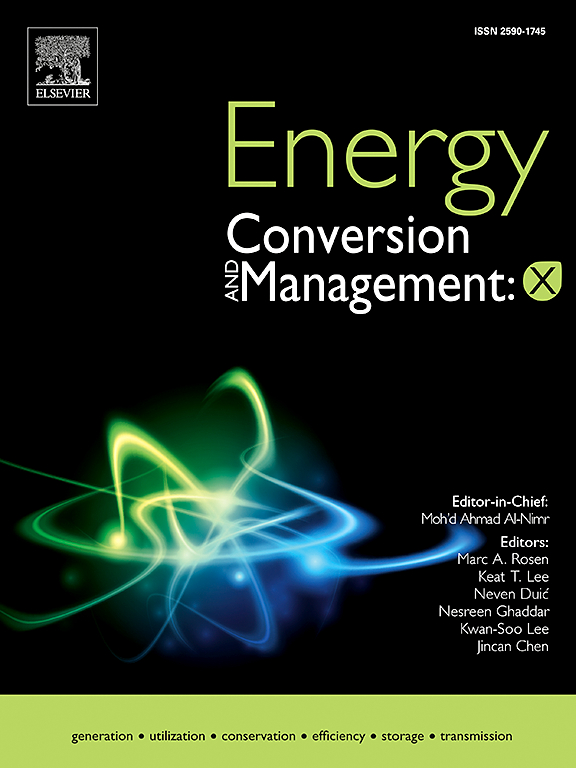Optimal dimensioning of renewable energy generation and storage systems
IF 7.1
Q1 ENERGY & FUELS
引用次数: 0
Abstract
With high energy demand and large available area, agricultural farms offer significant potential for renewable energy investments, like photovoltaic systems and electrical energy storages. However, the profitability of such investments depends strongly on self-consumption, so accurate planning requires computation-intensive simulation and optimization considering local consumption. This study presents a novel methodology for the optimal dimensioning and configuration of photovoltaic systems and electrical energy storages using efficient techniques from continuous non-linear optimization. Combining physical and economic models with measured consumption data, an investment’s net present value over 20 years is maximized. Using gradient-based solver WORHP, the simulation, optimal control, and optimal dimensioning of the local energy system are calculated simultaneously, allowing for efficient computation over an entire year of hourly data to capture both daily and seasonal variations.
The approach is demonstrated with simple use cases, including an exemplary day of a dairy farm’s consumption, for which optimal systems with and without storage achieve 77% and 43% of autarky, respectively. Saturation effects of optimal plant size can be observed when sizes are large enough for optimal self-consumption but not expanded further for grid export. With energy storage, this saturation is reached at higher values. Optimizing photovoltaic plants with different orientations to match the specific consumption patterns characteristic of the dairy farm achieves similar autarky as a single plant while reducing investment costs by more than 20%. While thorough validation and comparison against heuristic methods predominantly used in the field is part of ongoing research, the presented use cases demonstrate the flexibility and efficiency of the proposed method and highlight its promise as a planning tool in the agricultural domain and beyond.
可再生能源发电和储能系统的优化设计
农业农场对能源的需求量大,可用面积大,为可再生能源投资(如光伏系统和电能储存)提供了巨大潜力。然而,此类投资的盈利能力在很大程度上取决于自我消耗,因此精确规划需要计算密集型模拟和优化,并考虑当地消耗。本研究提出了一种新方法,利用连续非线性优化的有效技术,对光伏系统和电能储存进行优化尺寸和配置。通过将物理和经济模型与测量的消耗数据相结合,实现了 20 年内投资净现值的最大化。利用基于梯度的求解器 WORHP,可同时计算本地能源系统的模拟、优化控制和优化尺寸,从而对全年的每小时数据进行高效计算,以捕捉每日和季节性变化。当电厂规模足够大时,可以观察到最优电厂规模的饱和效应;当电厂规模足够大时,可以实现最优自用,但不能进一步扩大电网出口。如果使用储能技术,这种饱和效应会在更高的数值上出现。根据奶牛场的具体消费模式,优化不同方向的光伏电站,可实现与单个电站类似的自给自足,同时将投资成本降低 20% 以上。虽然与该领域主要使用的启发式方法进行彻底验证和比较是正在进行的研究的一部分,但所介绍的使用案例证明了所建议方法的灵活性和效率,并突出了其作为农业领域及其他领域规划工具的前景。
本文章由计算机程序翻译,如有差异,请以英文原文为准。
求助全文
约1分钟内获得全文
求助全文
来源期刊

Energy Conversion and Management-X
Multiple-
CiteScore
8.80
自引率
3.20%
发文量
180
审稿时长
58 days
期刊介绍:
Energy Conversion and Management: X is the open access extension of the reputable journal Energy Conversion and Management, serving as a platform for interdisciplinary research on a wide array of critical energy subjects. The journal is dedicated to publishing original contributions and in-depth technical review articles that present groundbreaking research on topics spanning energy generation, utilization, conversion, storage, transmission, conservation, management, and sustainability.
The scope of Energy Conversion and Management: X encompasses various forms of energy, including mechanical, thermal, nuclear, chemical, electromagnetic, magnetic, and electric energy. It addresses all known energy resources, highlighting both conventional sources like fossil fuels and nuclear power, as well as renewable resources such as solar, biomass, hydro, wind, geothermal, and ocean energy.
 求助内容:
求助内容: 应助结果提醒方式:
应助结果提醒方式:


